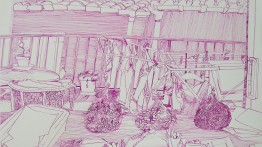Around The House: Drawing & Painting the Domestic Interior
Cost: $315.00
4 online sessions. THIS CLASS WILL TAKE PLACE OVER ZOOM. You will need a computer or device and we recommend that you download the latest version of the Zoom app.
REGISTER ONLINE (Registration opens at 10 am on September 7, 2022)
Sundays, November 13, 20, December 4 & 11, 2022 skipping November 27
11:00 AM–2:00 PM
Instructor: Josette Urso
In this online workshop, attention will be directed to the immediate, often unnoticed, and seemingly ordinary aspects of our everyday surroundings while also exploring the possibilities of working between categories, especially between drawing/painting and representation/abstraction.
Our homes and workspaces are ripe with intriguing subject matter and spontaneous natural arrangements. Domestic still-lifes can be found under the kitchen sink, in the bathroom, on our messy studio tables and within our junk drawers. These situations are not only convenient but lingering with them deepens our experience with the immediate world around us.
Working from observation, memory, and invention our emphasis will be on expanding our visual curiosity and being alert to the moment, while also letting go of preconceived ideas. Each week will focus on a different subject, point of view and/or medium. We think differently with different tools and participants will be encouraged to experiment with a variety of familiar and unfamiliar drawing and painting materials, including scissors and collage.
This class is ideal for anyone from the beginner to the more advanced student who enjoys improvisation and wants to expand their visual vocabulary and media.
MATERIALS LIST
- White or off-white Drafting or Nichiban Tape
- Scrap Paper
- A computer with a reliable Internet connection
- A drawing/painting area with your materials ready before the start of class
For those planning to work with drawing ~ choose materials that best suit your interests!
- Drawing Tools a small variety of fine point and bold pens and/or pencils and crayons of your choice. Some possibilities include: Kuretake brush pens, Faber-Castell Pitt Artist Pens, Pigma Micron Pens, Winsor and Newton Watercolor Markers, Caran D’Ache/Derwent watercolor pencils and/or crayons, Sharpies, Ebony Pencils, China Markers. Color is OK too!
- General Purpose Drawing Pad (approx. 11 x 14 “, medium weight, smooth and white) or any paper or surface you currently have available.
- White or off-white Drafting or Nichiban Tape
For those planning to work with painting ~ choose materials that best suit your interests!
- Watercolor, Gouache, Acrylic Paint suggested colors include
- Alizarin Crimson (a cool red)
- Cadmium Red Medium (a warm red)
- Cadmium Yellow Light
- Ultramarine Blue
- Ivory Black
- Titanium White
- Variations of these colors can also work if they include the three primaries: Red, Yellow and Blue as well as a black and a white. With watercolor or gouache, “neutral tint” is preferable to ivory black and a tube of white gouache or titanium white is suggested.
- Watercolor / Gouache Palette a white palette made of plastic, metal or ceramic. The “John Pike” is a standard palette with a lid, but you can also use other white surfaces such as a dinner plate, enameled baking tray, or plastic disposable party plates (often found at the dollar store). Acrylic Palette a disposable wax paper palette pad is convenient for easy cleanup.
- Brushes - choice of medium to large flats and rounds. Don’t be shy of large brushes.
- Paper Towels
- 2 or 3 water containers
- Palette knife (if using acrylic)
- Papers for all paint mediums- Pads, Blocks or Sheets. Paper is a very practical painting surface -- even for those working with acrylic. It is portable and lightweight. An assortment of surface types is recommended: cold press watercolor (has more texture) or hot press (smoother). This is a good opportunity to experiment. 11”x 14” or 18” x 24” are good sizes. Those working with acrylic can also consider canvases, boards or panels.
For those planning to incorporate collage ~ choose materials that best suit your interests!
- Magazine from your recycling bin
- Scissors
- X-acto knife, ruler and cutting board or cardboard to protect your table (optional)
- Glue stick /other adhesive (optional)
Course Code: DrawHome
Instructor(s): Josette Urso







